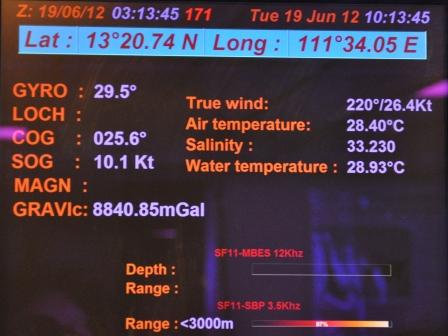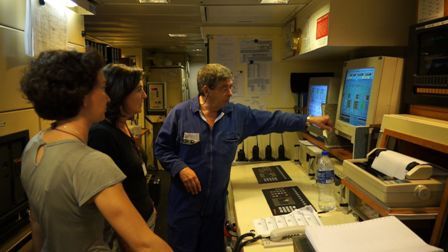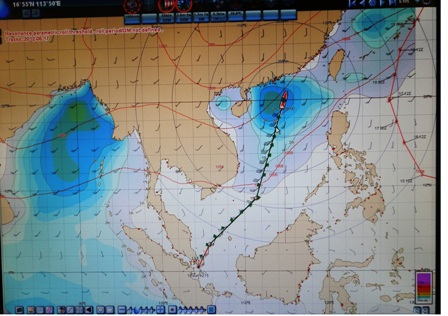In the next two weeks, GeoLog has the pleasure to host reports from Teachers at Sea. This educational programme, co-sponsored by the European Geosciences Union (EGU) and the French Polar Insitute (IPEV), gives school teachers the opportunity to take part in oceanographic cruises with scientists. This year, Sandrine Vivier and Ana Sánchez, teachers of Biology and Geology in Rodez (France) and Madrid (Spain), respectively, together with EGU’s Education Chair Carlo Laj, join scientists on board of the Marion Dufresne. The research vessel is navigating the South China Sea where teachers will work alongside scientists in collecting marine sediments to retrieve the secrets of deep ocean circulation and understand past variations of the Asian Monsoon. Check out the first and second posts of this series.
Report 3: How a research vessel works
The ‘heart’ of the Marion Dufresne, beating steadily 24/7, is its machinery. And today we received a very special treat: Chief Engineer Alain Rolland invited us for an hour visit to discover the inner secrets of the vessel.
From Deck E, which is the main deck for many operations, we descended a steep staircase to Deck D and started by visiting the control room. Here, a glance at the different and numerous control panels tells Alain that everything is working properly, or eventually what adjustments need to be done to correct small anomalies here and there.
We then moved further towards Decks B and A. The noise became very strong – so much so we were required to wear safety ear muffs – and the temperature increased: a thermometer hanging on a wall read 42°!
Here, Alain explained us a bit about how the boat works. Three diesel engines drive alternators that provide the necessary energy to two electric engines, which in turn propel the boat via two propellers. An electric motor is much more flexible than a diesel one, and this way of functioning is extremely important when the boat has to stay steady during the coring time.
The power from the diesel generators is also crucial to support life on board the vessel. It is used to evaporate sea water, which is distilled and mixed with some minerals that make it drinkable. As a result of this process, we can drink water from every tap on the Marion Dufresne. About 20 tons of water are produced in this way every day. Power for the entire electric system of the vessel is also generated by the diesel engines.
The highest possible power that can be generated is 6000 MW; in transit, in a balance between speed and efficiency, this value decreases to about 2500 MW. Life on board requires about 1000 MW.
At the prow, there is also another element of the vessel’s machinery: a transversal engine called a thruster. A propeller placed in a channel can project water either to the right (starboard) or to the left (port), which is very useful to stabilize the boat.
With more knowledge about own the Marion Dufresne works, we continue our itinerary. We’ll be sure to keep in touch!
By Sandrine Vivier, Ana Sánchez, and Carlo Laj



